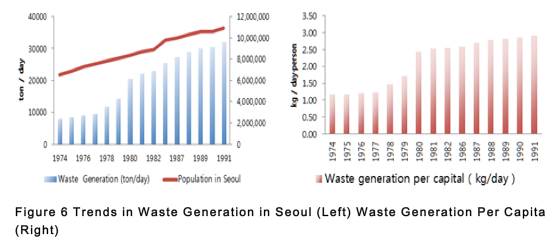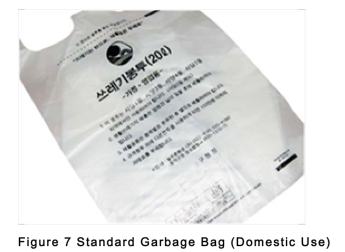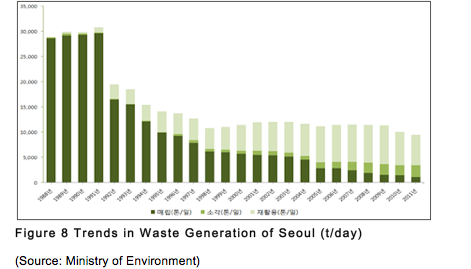Recycling (Smart Waste Management in Seoul)
Issues
As Seoul was rapidly developing in economic terms in the 1980s, the volume of the city’s waste skyrocketed as well. As of 1991, the average daily waste generated per capita in Seoul was 3 kg, remarkably larger than Japan’s 1 kg, and the UK’s and Germany’s 0.9 kg (Ministry of Environment, 2012). In particular, the situation at Nanjido Landfill Site, where leachate and toxic gas leaks and other environmental issues such as groundwater contamination reared their ugly heads, amplified the need to better manage the demand for waste services.
Meanwhile, siting and construction of waste treatment facilities resulted in local opposition and became more complicated in the 1990s when the local autonomy system was introduced, making the mediation of conflicts between local governments even more difficult. Though the Seoul Metropolitan Government (SMG) was able to secure the land for Sudokwon Landfill Site, use of the site was supposed to end in 2006. It soon became evident that expanding the waste treatment facilities would not meet the ever-increasing demand.

Solution - Volume-Based Waste Fee System (VBWF)

Officially launched in 1995, the volume-based waste fee system employs economic incentives. Based on a “pay as you throw” principle, users pay according to the amount of garbage they generate by having to purchase bags required to dispose of household waste. Implementation of the system entailed a significant change in public awareness toward waste disposal, drawing attention to such issues as the urgency to reduce waste and the costs related to waste disposal. As perceptions of the system changed, people’s behavior changed and support grew.
2.1. Planning
1) Preparation (Sept. 1992 ~ Dec. 1994)
Before full implementation, enforcement guidelines for volume-based waste fees were defined by the government. Meanwhile, public hearings took place to inform the civil service, the general public and professionals from diverse fields on the new waste management system and to gather public opinions. Over the next couple of years, the Ministry of Environment conducted a pilot project in selected areas for each metropolitan city and province. As positive results came out of these projects, other regions joined on their own. Seoul-wide participation resulted in a remarkable 40% reduction in waste and doubled the rate of recycling. During the preparation stage, the city extensively reviewed and examined the new waste management system to solicit opinions from relevant ministries and different social sectors. Working with the media to promote the system via television and radio was the responsibility of the volume-based waste fee system headquarters and situation room.
2) Introduction (Jan. 1, 1995)
On January 1, 1995, the volume-based waste fee system launched nationwide. The previous waste collection fee was replaced with the pre-paid garbage bag mandated by the local authorities. The bags were to be filled to the dotted line and put out in front of houses and apartment buildings, and recyclable materials were to be separated into paper, glass, metal, and plastic. Households wishing to dispose of large items such as home appliances and furniture were to report to the local dong-district office, where they would pay an extra fee and wait for collection.
2.2. Implementation
1) Legal Framework
The legal grounds for the volume-based waste fee system was found in Article 13 and 14 of the 1991 Waste Management Act, supplemented by the 1995 revision. The guidelines from the Ministry of Environment on the volume-based waste fee system provide the framework for regional ordinances. Based on these guidelines, mayors and district office heads decide bag prices according to the type and amount of waste and are authorized to commission the manufacture, sales and distribution of the garbage bags (Korea Environment Institute, 2011).
2) Standard Garbage Bags
The price of standard garbage bags is determined by local ordinances, in consideration of the previous garbage collection fee, local government finances and the local standard of living. Whereas the previous method of waste collection used a flat-rate system, the specific financial situation of the local government is reflected in the bag pricing under the volume-based waste fee system. Garbage bags are sold at places designated by local governments based on demand from households and businesses. Sales and distribution of bags for business purposes are commissioned to private companies.
| Capacity | 2ℓ | 3ℓ | 5ℓ | 10ℓ | 20ℓ | 30ℓ | 50ℓ | 75ℓ | 100ℓ |
|---|---|---|---|---|---|---|---|---|---|
| Average price | 52 | 72 | 99 | 187 | 363 | 547 | 897 | 1,363 | 1,840 |
Table 3 Price of Seoul Standard Garbage Bag (2012)
(Source: Seoul Metropolitan Government)
The composition of and materials used in standard garbage bags vary. HDPE bags are primarily for incineration plants while HDPE bags are to be transported to landfills. The standard bags also vary in color and size according to their intended pur
| Type of bag | Bag size |
|---|---|
| Domestic wastes (white) | 3ℓ, 5ℓ, 10 ℓ, 20 ℓ, 30 ℓ, 50 ℓ, 75 ℓ, 100 ℓ |
| Food wastes (yellow) | 1ℓ, 2ℓ, 3ℓ, 5ℓ |
| Business wastes (orange) | 5 ℓ, 10 ℓ, 20ℓ, 30ℓ, 50ℓ, 75ℓ, 100ℓ |
| Public purposes (blue) | 30ℓ, 50 ℓ, 100 ℓ |
| Construction debris, glass wastes | PP sack or gunny bag |
Table 4 Different Types and Sizes of Standard Waste Bag
1) Sales of Standard Garbage Bags
Since 2005, sales of garbage bags have increased, with the exception of 2007, in the wake of the global financial crisis. Starting in 2005, food waste was collected separately in special reusable containers which has significantly reduced revenues from garbage bag sales.
| Year | 2003* | 2004* | 2005 | 2006 | 2007 | 2008 | 2009 |
|---|---|---|---|---|---|---|---|
| Units sold (1,000) | 266,477 | 272,233 | 37,358 | 38,101 | 37,581 | 38,943 | 39,989 |
| Sales (KRW million) |
125,828 | 118,543 | 30,638 | 31,059 | 30,597 | 35,269 | 38,164 |
Table 5 Standard Waste Bag Sales of Seoul (Source: Korea Environment Institute, 2011)
2) Financial Viability of the Waste Management Budget
Financial Viability Rate = (revenue from sales of garbage bags + revenue from sales of recyclable materials + large item collection fees + etc.) / annual waste management cost
The financial viability rate of Seoul’s waste management budget was low as of 2009, at 34.6%. It improved by 1% between 2003 and 2004 from 35.4% to 35.4%. This implies the total spending on waste management exceeds the revenue from sales of recyclable materials and standard garbage bags and fees paid for disposal of large items. The garbage bags used for public facilities and bags subsidized for the underprivileged are purchased using local budgets. The cost for carrying waste into the final disposal facilities is also borne by local governments. In other words, revenue from fees and commissions lower than the actual costs for these services is the reason for the low financial viability rate in waste management administration. To leverage the waste management budget, a variety of measures are under consideration, including increasing the price of garbage bags.
| Year | 2003 | 2004 | 2005 | 2006 | 2007 | 2008 | 2009 |
|---|---|---|---|---|---|---|---|
| Financial independence (%) | 35.4 | 24.4 | 43.2 | 35.1 | 35.2 | 35.0 | 34.6 |
Table 6 Financial Independence of Seoul's Cleaning Budget
(Source: Korea Environment Institute, 2011)
2.4. Challenges
1) Illegal Dumping
2) Engaging Citizens
Results
3.1. Output
1) Reduction of Waste

2) Increased Recycling from Collection of Separated Waste
3) Generating Revenue & Reducing Costs
3.2. Outcomes
1) Diversification of Waste Treatment Methods
2) Revitalization of the Recycling Industry & Technological Advancement
3) Improved Public Awareness of Waste-related Issues